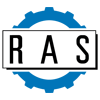Folding machines are used to give a sheet metal product its shape. Folding machines are fast, efficient, and precise. They are used in a range of industries for many different products and project types.
Folding machines are easily identified by their large support tables and swinging “folding beam”, which bends the flange while the workpiece remains flat on the support table. These machines are ideal for many circumstances, especially with large blanks that would otherwise be difficult to handle.
Folding Machine Features
Folding machines operate in a similar way as historic handbrake bending. Depending on the level of automation, a workpiece is referenced against CNC-controlled backstops that are nested in the support table. A clamping axis, called the upper beam, is driven by servo-electric motors to a specific position to hold the blank in place. Once the material is clamped, the iconic swing-beam folding arm will drive in an arc, carrying the flange to the desired angle. On manual machines, this referencing happens for each bend; on semi-automated systems, this reference step happens only once per side; on fully-automated solutions, this reference occurs only once per part!
Learn more about the comparison between metal folding and press brake bending.
There are many levels of folding machines, but all of them follow the same sequence for air-bending a desired angle: position -> clamp -> bend. The process is perfect for flexible applications because the tooling is not specific to the material thickness or angle required. “Universal” tool geometries allow for unlimited angle possibilities and are rated up to the maximum machine capacity and height. These tools should last for many years because of the unique process of swing-beam folding. Flanges are bent to the correct angle with flat tooling that eliminates scratching or sliding on the workpiece. Not only does this equate to better quality parts, but it also means that there is almost zero tool wear.
There are several types of folding machines. On systems equipped with segmented clamping tools, a new part can be set up by rearranging the tool segments on the tool rail. Machines without automatic tool changers still simplify the setup process by telling the operator where to put tool stations. This common tooling allows for fast changeover between parts and makes it easy for a single employee to program, operate, and set up the machine for any compatible part.
The clamping tool of a folder allows the folding beam to form an acute angle bend for hemming applications. That acute angle is then positioned under the clamping tool foot to close the hem to a specific height. This height can be selected for parallel hems, teardrop hems, or even open hems used in assembly.
When the part needs a large radius to be formed, the same tooling can be used on a folding beam to smoothly make incremental bends until the necessary radius is achieved.
While not a one-size-fits-all solution, folders offer maximum flexibility for a wide variety of needs.
Watch this video on some of the folding machines RAS Systems offers.
Advantages of Folding Machines
Machine Accuracy: Folding machines clamp and bend the flange as it lies flat on the gauging table. You can expect the same quality at the beginning and end of a shift since the entire weight of the part is resting on the table. The CNC-driven backstops are incredibly accurate, which pushes all blank tolerance out in the very first flange. The drives for all critical axes are CNC-controlled, servo-electric motors which are reliable and low-maintenance with very high precision in positioning.
Faster Set-Up: Universal tooling makes set-up as simple as rearranging the segments. No wall of tool storage, no complicated tool clamps. Adjustment for different material thickness is done under CNC control automatically, without any manual adjustment needed.
Sensitive Materials and Cosmetic Parts: The flat plane of our bending tooling nearly eliminates any friction between tool and material. On all but the most sensitive surfaces, there will be zero evidence of bend lines. For the most sensitive material, we offer a composite insert for the tooling to eliminate all possible marking.
Operator Ease: Folding machines are safe and easy to operate. The machine control indicates to the operator what needs to be done, and when. Folders allow companies to introduce bending to new operators, freeing up their most experienced employees to add value to other processes. Once an operator spends a day heaving around large parts on a press brake, they are the first ones in line to run to the folder and give their shoulders and back a break!
Quality Can’t Be Beat
RAS folding machines are fast, efficient, and precise. There’s no better tool for your fabrication arsenal to add value, increase productivity, and lower operating costs.
If you have any questions regarding folding machines please visit our website for more information or request a quote today!
Founded in 1929, RAS builds metal bending, cutting, and forming equipment, as well as fabrication software, and is known for its high quality, reliability, and precision.
